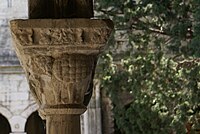Tarasque

The Tarasque is a fearsome legendary dragon from Provence, in southern France, tamed in a story about Saint Martha. On 25 November 2005 the UNESCO included the Tarasque on the list of Masterpieces of the Oral and Intangible Heritage of Humanity.[1]
Legend
Legend reported among others by the Golden Legend[2] has it that the creature inhabited the area of Nerluc in Provence, France, and devastated the landscape far and wide. The Tarasque was a sort of dragon with six short legs like a bear's, an ox-like body covered with a turtle shell, and a scaly tail that ended in a scorpion's sting. It had a lion's head.[3]
The Tarasque was said to have come from Galatia which was the home of the legendary Onachus, a scaly, bison-like beast which burned everything it touched (this creature is similar to the Bonnacon). The Tarasque was the offspring of the Onachus and the Leviathan of biblical account; disputably a giant sea serpent.
The king of Nerluc had attacked the Tarasque with knights and catapults to no avail. But Saint Martha found the beast and charmed it with hymns and prayers, and led back the tamed Tarasque to the city. The people, terrified by the monster, attacked it when it drew nigh. The monster offered no resistance and died there. Martha then preached to the people and converted many of them to Christianity. Sorry for what they had done to the tamed monster, the newly-Christianized townspeople changed the town's name to Tarascon.
The story of the Tarasque is also very similar to the story of Beauty and the Beast and King Kong. The monster is charmed and weakened by a woman and then killed when brought back to civilization. A similar idea is found in the myths of Enkidu and the unicorn: both are calmed by sending them a woman. The description and legend of this creature is curiously similar to other dragons of French folklore such as Gargouille and Peluda.
-
Painting of St. Martha and the Tarasque, attributed to André Abellon, in the Basilica of Mary Magdalene at Saint-Maximin-la-Sainte-Baume.
-
The Tarasque, near King René's castle in Tarascon.
-
A carved early Gothic column capital in the cloister of the Church of St. Trophime in Arles, 14th century, depicting the Tarasque; it is one of several carvings here that show legends of local folklore as well as biblical figures.
Cultural impact

The Tarasque is featured on the coat of arms of the city of Tarascon. A festival is held every year there on the last Sunday of June to remember the Tarasque, as well as Tartarin, the main character of Alphonse Daudet's Tartarin de Tarascon.
A legendary marine creature reported to live in Vietnam's Halong Bay was also called "Tarasque" by the French who ruled the area at the time.[4]
The French military named a towed 20 mm anti-aircraft gun (53 T2) after the Tarasque.
The Tarasque is one of the statues of the Corpus Christi procession of many Spanish cities (Valencia,[5] Granada...).
See also
- Tarascosaurus, a dinosaur named after the Tarasque
- Tarrasque (Dungeons & Dragons)
- Mont Gerbier de Jonc
Notes
- ^ United Nations Educational, Scientific and Cultural Organization | Culture
- ^ "The Life of Saint Martha", text from the Golden Legend.
- ^ For a detailed analysis of the Tarasque legend, see: 'The Dragon and the Holy Cross', in: Ingersoll, Ernest, et al., (2013). The Illustrated Book of Dragons and Dragon Lore. Chiang Mai: Cognoscenti Books. ASIN B00D959PJ0
- ^ "Ha Long Bay." Encyclopædia Britannica. 2007. Encyclopædia Britannica Online. 28 February 2007 secure.britannica.com
- ^ JDiezarnal.com
References
- Ingersoll, Ernest, et al., (2013). The Illustrated Book of Dragons and Dragon Lore. Chiang Mai: Cognoscenti Books. ASIN B00D959PJ0
- Shuker, Karl (1995). Dragons: A Natural History. New York: Simon & Schuster. ISBN 9780684814438. OCLC 32236086.



